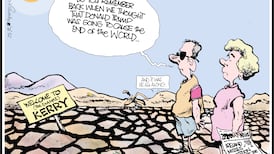In my distant Belfast days, I used to pass the time of day in the Bank Bar in Castle Street, near the city centre, writes Kevin Myers.
Various odd creatures would gather there - lefty republicans, alcoholics, journalists, unaligned Protestants, students, semi-hippies, and wasters of various kinds, a category to which I most emphatically belonged. There was one young man who used to drop into the Bank Bar regularly, and whom I rather took to. He seemed to be quite shy, never saying very much, but he had an engaging little smile, and a slightly baffled air, as if the world was working in ways that he didn't quite understand. His name was Jimmy Brown.
I came across Jimmy Brown's name again the other day when reading Henry McDonald's highly engaging memoir of (his still young) life, Colours - From Bombs To Bloom (Mainstream Publishing). Here I discovered that, years after I used to see him in the Bank, Jimmy Brown was involved in the murder of John McQuoist McMaster, a shopkeeper and Royal Navy reservist, in his little craft shop round the corner from the Bank Bar.
Poor John McQuoist's crime was that, as a British naval reservist in Belfast, he was somehow or other responsible for British naval operations against Saddam Hussein's forces during the 1991 Gulf War. A couple of days after the murder, Henry - who is nowadays Northern Ireland correspondent for the Observer - interviewed Jimmy Brown in his home on the Falls Road. "Our friends in the Middle East will notice this," pronounced Brown, with ludicrous bombast.
By this time, Jimmy Brown had grown from being the shy, smiling figure of my acquaintance into a cold-blooded monster, a leader of the Irish People's Liberation Army - an organisation which would properly belong to Monty Python's Life of Brian, save for its bottomless appetite for evil. The IPLO was of little danger to the British army, but of considerable danger to its members, to other republicans and to whatever passing Protestants it could get its hands on. Only a group of madmen so utterly lost to all common sense could possibly think that Saddam Hussein, with the blood of millions on his hands, would have noticed the murder of a shopkeeper in Belfast.
There is a symmetry to Brown's involvement with the death of a helpless part-time sailor: a year later, he was himself shot dead, and with the very same gun. Though not himself a leading gunman - he apparently merely assisted in killings - he had become something of a windbag. He had given the graveside oration at the funeral of Gerald Steenson, also known as Dr Death, who had himself been responsible for numerous killings, mostly in inter-republican feuds of a savagery that would fit well in Falluja or Mosul.
The first killing loosely attributed to Steenson was of a British soldier in the Divis Flats area - but since I was there, I can say that nobody can be sure who actually shot him. I saw a group of 14- to 15-year-old boys with - for their tiny body-size - huge second World War Garand rifles fire at a British army personnel carrier. A chance round, which could have come from any one of the youngsters, entered the APC and fatally injured a young soldier inside. Steenson claimed the hit.
I had happened to be present in the flats because serious rioting had earlier broken out around there following the shooting by paratroopers of the Official IRA leader Joe McCann that morning in the Markets area, where Henry McDonald was from. Henry knew McCann well: the gunman used the McDonald home as a safe house, to eat and dye his hair as a disguise.
Perhaps surprisingly, Henry describes his childhood in the Markets, even in the middle of the Troubles, as "idyllic". In his teenage years, he joined the Official IRA, which preached some Marxist mumbo-jumbo and which favoured a Moscow-style Marxist workers' paradise and which was powerful in the Markets.
He has come some long way since then, making a journey a few other Belfast nationalists have made, usually via the now-defunct official republican movement. Gradually they dissociated themselves from most of the trappings of republicanism before they, in a similar series of ideological ecdyses, shed the various layers of Marxist epidermis. As a group, they now tend to be pro-American free marketers, and like Henry, supported the US-led invasion of Iraq.
So why did Jimmy Brown, my shy, retiring youngster of the Bank Bar, turn into a cold-blooded, gibberish-ranting monster? Why did his contemporary, Henry McDonald, who had enlisted in the junior wing of the IRA at around the same time, go on to become a respected journalist, historian and memoirist? What are the influences in life upon two young men, of comparable background and age, and who had taken the oath of allegiance to the same illegal paramilitary group, which propelled them in such radically different directions?
Maybe the differences are simply ones of luck. Maybe Jimmy Brown had the misfortune to associate with unbelievable monsters like Dr Death. Or was he wicked at core, and infused with evil even when I thought him a charming youngster? Was Henry inevitably going to escape the malign force-field of paramilitarism, because of his own moral compass and his own intellectual ambitions? Nothing is inevitable in life, save that which Jimmy Brown has already encountered. Colours is Henry McDonald's splendid account of another and vastly richer journey, from the impoverished hovels of the Markets in the 1970s to his life as a journalist today.









